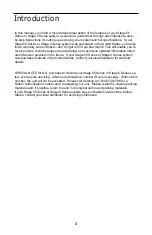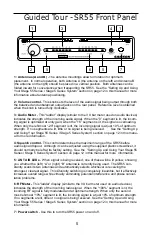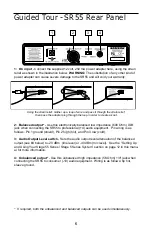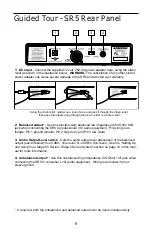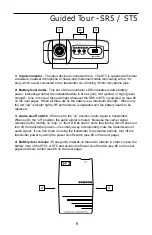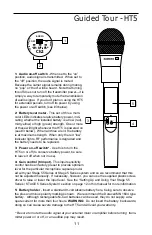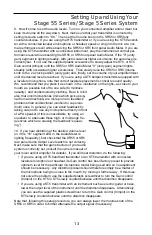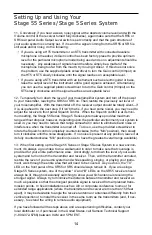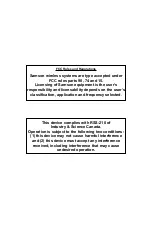
11
Guided Tour - HT5
1: Audio on-off switch - When set to the “on”
position, audio signal is transmitted. When set to
the “off” position, the audio signal is muted.
Because the carrier signal remains during muting,
no “pop” or “thud” will be heard. Note that turning
this off does not turn off the transmitter power—it is
simply a way to temporarily mute the transmission
of audio signal. If you don’t plan on using the HT5
for extended periods, turn off its power by using
the power on-off switch (see #3 below).
2: Battery level meter - This set of three multi-
color LEDs indicates relative battery power, indi-
cating whether the installed battery is at low (red),
mid (yellow) or high (green) strength. One or more
of these will light whenever the HT5 is powered on
(see #3 below). When all three are lit, the battery
is at maximum strength. When only the red “low”
indicator lights, RF performance is degraded and
the battery needs to be replaced.
3: Power on-off switch* - Use this to turn the
HT5 on or off (to conserve battery power, be sure
to leave it off when not in use).
4: Gain control (trimpot) - This input sensitivity
control has been factory preset to provide optimum
level for the particular microphone capsule provid-
ed with your Stage 55 Series or Stage 5 Series system and so we recommend that this
not be adjusted manually. If necessary, however, you can use the supplied plastic screw-
driver to raise or lower the input level. See the “Setting Up and Using Your Stage 55
Series / STAGE 5 Series System” section on page 12 in this manual for more information.
5: Battery holder - Insert a standard 9-volt alkaline battery here, being sure to observe
the plus and minus polarity markings shown. We recommend the Duracell MN 1604 type
battery. Although rechargeable Ni-Cad batteries can be used, they do not supply ade-
quate current for more than four hours. WARNING: Do not insert the battery backwards;
doing so can cause severe damage to the HT5 and will void your warranty.
* Be sure to mute the audio signal at your external mixer or amplifier before turning trans-
mitter power on or off, or an audible pop may result.
MIN
MAX
LEVEL
POWER
ON
OFF
5
3
4
1
AUDIO
LOW
MID HIGH
BATTERY LEVEL
Ch2
OFF
ON
2
FC
C
ID
C
C
R
H
T
5
0
1
6
8




